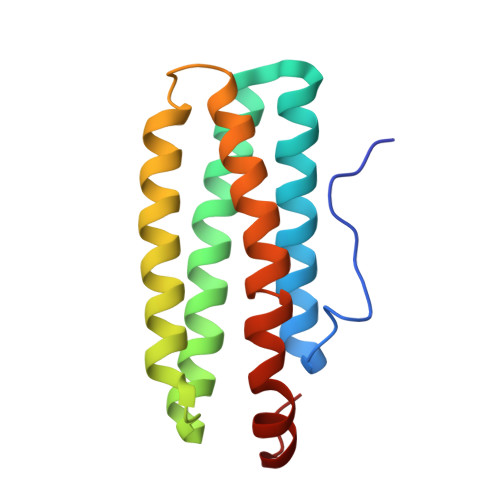Crystal structure, exogenous ligand binding, and redox properties of an engineered diiron active site in a bacterial hemerythrin
Okamoto, Y., Onoda, A., Sugimoto, H., Takano, Y., Hirota, S., Kurtz Jr., D.M., Shiro, Y., Hayashi, T.(2013) Inorg Chem 52: 13014-13020
- PubMed: 24187962
- DOI: https://doi.org/10.1021/ic401632x
- Primary Citation of Related Structures:
3WAQ - PubMed Abstract:
A nonheme diiron active site in a 13 kDa hemerythrin-like domain of the bacterial chemotaxis protein DcrH-Hr contains an oxo bridge, two bridging carboxylate groups from Glu and Asp residues, and five terminally ligated His residues. We created a unique diiron coordination sphere containing five His and three Glu/Asp residues by replacing an Ile residue with Glu in DcrH-Hr. Direct coordination of the carboxylate group of E119 to Fe2 of the diiron site in the I119E variant was confirmed by X-ray crystallography. The substituted Glu is adjacent to an exogenous ligand-accessible tunnel. UV-vis absorption spectra indicate that the additional coordination of E119 inhibits the binding of the exogenous ligands azide and phenol to the diiron site. The extent of azide binding to the diiron site increases at pH ≤ 6, which is ascribed to protonation of the carboxylate ligand of E119. The diferrous state (deoxy form) of the engineered diiron site with the extra Glu residue is found to react more slowly than wild type with O2 to yield the diferric state (met form). The additional coordination of E119 to the diiron site also slows the rate of reduction from the met form. All these processes were found to be pH-dependent, which can be attributed to protonation state and coordination status of the E119 carboxylate. These results demonstrate that modifications of the endogenous coordination sphere can produce significant changes in the ligand binding and redox properties in a prototypical nonheme diiron-carboxylate protein active site.
- Department of Applied Chemistry, Graduate School of Engineering, Osaka University , Suita, Osaka 565-0871, Japan.
Organizational Affiliation:

















